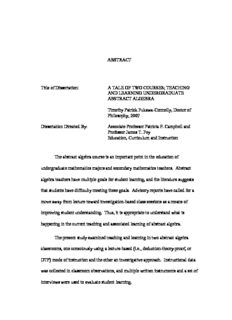
TEACHING AND LEARNING UNDERGRADUATE ABSTRACT ALGEBRA Timothy Patrick Fu PDF
Preview TEACHING AND LEARNING UNDERGRADUATE ABSTRACT ALGEBRA Timothy Patrick Fu
ABSTRACT Title of Dissertation: A TALE OF TWO COURSES; TEACHING AND LEARNING UNDERGRADUATE ABSTRACT ALGEBRA Timothy Patrick Fukawa-Connelly, Doctor of Philosophy, 2007 Dissertation Directed By: Associate Professor Patricia F. Campbell and Professor James T. Fey Education, Curriculum and Instruction The abstract algebra course is an important point in the education of undergraduate mathematics majors and secondary mathematics teachers. Abstract algebra teachers have multiple goals for student learning, and the literature suggests that students have difficulty meeting these goals. Advisory reports have called for a move away from lecture toward investigation-based class sessions as a means of improving student understanding. Thus, it is appropriate to understand what is happening in the current teaching and associated learning of abstract algebra. The present study examined teaching and learning in two abstract algebra classrooms, one consciously using a lecture-based (i.e., deduction-theory-proof, or DTP) mode of instruction and the other an investigative approach. Instructional data was collected in classroom observations, and multiple written instruments and a set of interviews were used to evaluate student learning. Each instructor hoped students would develop a deep and connected knowledge base and attempted to create classroom environments where students were constantly engaged as a means of doing so. In the lecture class, writing proofs was the central activity of class meetings; nearly every class period included at least one proof. In the investigative class, the processes of computing and searching for patterns in various structures were emphasized. At the end of the semester, students demonstrated mixed levels of proficiency. Generally, students did well on items that were relatively familiar, and poorly when the content or context was unfamiliar. In the DTP course, two students demonstrated significant proficiency with analytical argument; the remainder demonstrated mixed proficiency with proof and very little proficiency with other content. The students in the investigative class all seemed to develop similar levels of proficiency with the content, and demonstrated more willingness to explore unknown structures. This study may prompt discussions about the relative importance of developing proof-proficiency, students’ ability to formulate and investigate hypotheses, developing students’ content knowledge, and students’ ability to operate in and analyze novel structures. A TALE OF TWO COURSES; TEACHING AND LEARNING UNDERGRADUATE ABSTRACT ALGEBRA By Timothy Patrick Fukawa-Connelly Dissertation submitted to the Faculty of the Graduate School of the University of Maryland, College Park, in partial fulfillment of the requirements for the degree of Doctor of Philosophy 2007 Dissertation Committee: Dr. Patricia F. Campbell, Chair Dr. James T. Fey, Chair Dr. Kenneth Berg Dr. Steven Selden Dr. Lawrence Clark © Copyright by Timothy Patrick Fukawa-Connelly 2007 DEDICATION To my wife Kate ii ACKNOWLEDGEMENTS I want to thank: • Dr. James Fey and Dr. Patricia Campbell for their guidance and support. • Dr. Nadine Connell’s friendship, experience and occasional snacks made my time as a graduate student far richer than I had hoped for. • My parents, for everything. iii TABLE OF CONTENTS DEDICATION..........................................................................................................ii ACKNOWLEDGEMENTS......................................................................................iii TABLE OF CONTENTS..........................................................................................iv List of Tables...........................................................................................................vii List of Figures........................................................................................................viii CHAPTER 1: RATIONALE AND SIGNIFICANCE.................................................1 Rationale...............................................................................................................1 Abstract Algebra and the Undergraduate Mathematics Curriculum....................1 Teaching and Learning Advanced Mathematics.....................................................5 Teaching and Learning Algebra.........................................................................8 Research Questions and Overall Study Design.....................................................10 Teaching and Learning in the DTP Class.........................................................11 Teaching and Learning in the Investigative Class.............................................11 Comparison of DTP and Investigative Class Teaching and Learning................12 Developed Mathematical Proficiency in DTP and Investigative Abstract Algebra Classes.............................................................................................................12 Limitations of the Study.......................................................................................13 CHAPTER 2: LITERATURE REVIEW..................................................................15 Teaching Advanced Mathematics........................................................................16 DTP Teaching..................................................................................................16 Investigative Teaching.....................................................................................20 Teachers’ pedagogical decisions......................................................................33 Summary.........................................................................................................38 Student learning...................................................................................................39 Conceptual Understanding...............................................................................40 Procedural fluency...........................................................................................47 Strategic competence.......................................................................................48 Adaptive reasoning..........................................................................................50 Productive disposition......................................................................................54 Summary.........................................................................................................57 CHAPTER 3: CONTEXT AND METHODOLOGY...............................................59 Introduction.........................................................................................................59 Context................................................................................................................59 The Mathematics Department..........................................................................60 The Role of the Researcher..................................................................................66 Data Sources........................................................................................................67 Paper-and-pencil instruments...........................................................................68 Data Analysis ......................................................................................................77 Analysis of abstract algebra instruction............................................................78 Analysis of student learning.............................................................................80 CHAPTER 4: LEARNING ABOUT TEACHING...................................................82 Methodology.......................................................................................................83 iv Proof in the DTP class.....................................................................................84 Characterizing DTP Teaching..............................................................................98 Teaching Scripts..............................................................................................99 Salient characteristics of the observed teaching scripts...................................108 Student Scripts...............................................................................................112 Summary of DTP teaching.................................................................................113 Analysis of Teaching in the Investigative Class .................................................115 Teaching scripts.............................................................................................116 Salient characteristics of the observed teaching scripts...................................134 Student Scripts...............................................................................................138 A Comparison of the Observed Teaching Scripts...............................................139 Teaching scripts which differentiate the sections............................................141 Shared teaching scripts...................................................................................143 Summary...........................................................................................................148 CHAPTER 5: STUDENT PROFICIENCY WITH ABSTRACT ALGEBRA........152 Introduction and Methodology...........................................................................153 Identities, Inverses, and Units............................................................................156 Understanding Identities, Inverses, and Units.................................................156 Opportunities to Learn...................................................................................157 Assessment of Student Understanding............................................................158 Summary of Demonstrated Proficiency with Identity, Inverse, and Unit.........176 Polynomials.......................................................................................................180 Understanding polynomials............................................................................180 Idealized Student Proficiency with Polynomials.............................................181 Opportunities to Learn...................................................................................182 Assessment of Student Understanding............................................................184 Evidence of Student Proficiency....................................................................185 Summary of Demonstrated Proficiency with Polynomials..............................205 Structure/substructure and what is inherited.......................................................207 Understanding groups, rings and fields...........................................................208 Idealized Student Proficiency with Structure..................................................209 Opportunities to Learn...................................................................................210 Assessment of Student Understanding............................................................211 Evidence of Student Proficiency....................................................................213 Summary of Demonstrated Proficiency with Structure...................................223 Proof proficiency...............................................................................................224 Idealized Student Proficiency with Proof.......................................................225 The local situation..........................................................................................226 Opportunities to Learn...................................................................................227 Assessment of Student Understanding............................................................228 Evidence of Student Proficiency....................................................................228 Polynomial Proofs .........................................................................................237 Summary of Demonstrated Proof Proficiency................................................248 Comparing the Demonstrated Proficiencies of the Two Classes.........................251 Conclusion.........................................................................................................252 v CHAPTER 6: SUMMARY, IMPLICATIONS AND DIRECTIONS FOR THE FUTURE...............................................................................................................262 Teaching............................................................................................................262 Students’ Demonstrated Proficiencies................................................................265 Limitations of the Current Study........................................................................269 Implications for the Field...................................................................................271 Directions for Future Study................................................................................274 APPENDIX A: STUDENT BACKGROUND ASSESSMENT.............................277 APPENDIX D: END-OF-SEMESTER WRITTEN ASSESSMENT.....................280 REFERENCES......................................................................................................283 vi List of Tables Table 1. Data sources………………………………………………………………..69 vii
Description: